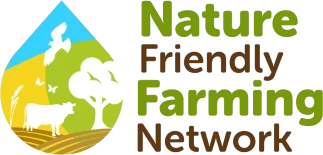Nikki and her husband James run Grampian Graziers using their small herd of native breed cattle as ecological engineers, predominantly in an agroforestry system. They are working with other landowners to expand their capacity and grow their herd.

Nikki Yoxall - Howemill Farm, Aberdeenshire

The natural world is abundant and diverse, which we often see in hedgerows and other wild places. Over time, conventional farming techniques have simplified the species present on farm, and so bringing biodiversity back means embracing complexity and creating the conditions that allow for diverse abundance to return to farms. This can mean embracing messy corners and weeds!
Nikki Yoxall
What actions have you taken on farm to address the current biodiversity crisis?
We have undertaken hedge and riparian planting with a mix of native broadleaf tree species such as rowan, holly, birch, oak, hawthorn, elder, dog rose and crab apple. These species provide habitat and year-round food for bird.
By mob grazing our cattle we keep the grass fairly long which creates habitat for a range of amphibians, invertebrates and small mammals. These all act as a food source to birds such as owls and merlins and other larger mammals such as pine marten, stoats and weasels. Tall grass grazing with lots of time for rest and recovery of the sward means flowers get the opportunity to grow without getting grazed. This approach has seen ragged robin, northern marsh orchid, birds foot trefoil and a range of vetches flowering in our pastures.
We have made some simple pond scrapes in areas where water accumulates, which are now full of frog and toad spawn in the spring. They also act as watering points for other species throughout the year.
How has collaborating with others helped you in working towards achieving biodiversity goals?
The Woodland Trust has supported us with trees for our hedge planting and we have worked with a local Climate Action group to offer them land to plant trees on with their volunteers.
I have recently joined a dung beetle WhatsApp group to help with identification.
We are members of several farmer networks which have been helpful for sharing ideas and learning as new entrants. Working with our neighbours to graze their land, we have been able to build longer rest periods into our grazing plan which has biodiversity benefits.
What does ‘Nature Means Business’ look like on your farm? What part has nature played?
Agroforestry allows us to outwinter our cattle, so they live outside all year round. By accessing a range of nutrient dense tree leaves, our cattle stay healthy and can even self-medicate by browsing willow, which contains salicylic acid – the same stuff found in aspirin. The nutritional benefits of tree leaves reduce the need for additional minerals helping us to reduce costs.
Tannins in trees can act as a natural anthelmintic, and in conjunction with Faecal Egg Counting we have not had to worm our cattle. This helps dung beetle and other invertebrate populations, as well as making business sense.
Trees not only benefit the ecosystem functioning on our farm, but they also play a central role in keeping costs down and enabling our direct beef sales to be profitable.
How does Bringing Biodiversity Back contribute to supporting Scotland to achieve Net Zero by 2045?
Increasing the number and density of plant species means the photosynthetic rate of our farm is high – more plant leaves means more solar panels converting solar energy and capturing carbon dioxide through photosynthesis. This draw down is a key part of our farming business, but in addition, by reducing our external inputs, we are also reducing bringing in nutrients and energy-heavy resources which all have a carbon footprint.
Farming in a way that integrates livestock and trees through agroforestry increases biodiversity as well as increasing carbon sequestration. We can produce nutrient dense beef whilst addressing climate change and biodiversity loss.
Are there regionally specific species or activities that have shaped your thinking in addressing biodiversity loss?
Whilst we see lots of birds of prey here like our resident buzzards, owls and even an osprey, we have only just seen our first red kites this year. We hope the high numbers of field voles that thrive in our longer pastures will provide a food source for them and keep them returning. Aberdeenshire is famous for its beef production, and we want to align with that tradition but do it in a way that increases species diversity – by mob grazing we give our fields lots of rest time between grazings, which means a wide range of flowers can come through, which is great for pollinators.
What advice would you give to farmers and crofters looking to Bring Biodiversity Back to their farms?
Mob grazing has been a game changer for us, both in terms of grass productivity but also seeing the increased sward diversity benefits, I’d recommend anyone with livestock investigates it as a grazing strategy.
